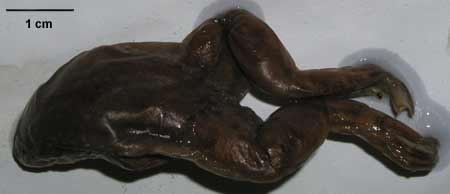Xenopus laevis, the African clawed frog, derives its name from the keratinous claws that cover its medial toes and its geographic range, which covers much of southern Africa. Xenopus is highly aquatic and bears several adaptations for this environment, including a dorsoventrally flattened body, dorsally directed eyes, the presence of a lateral line system throughout life, and large muscular hindlimbs. These frogs are especially bizarre considering that they lack tongues, vocal sacs, and vocal chords (Cannatella and De Sa, 1993).
Xenopus is a member of the Pipidae, a taxon defined as the most recent common ancestor of Xenopus, Silurana, Hymenochirus, Pseudhymenochirus, and Pipa, and all of its descendents (Ford and Cannatella, 1993). Traditionally, Xenopus was regarded as occupying a basal position within the Pipidae. More recent phylogenetic analyses indicate that Xenopus forms the sister taxon to Silurana (Cannatella and De Sa, 1993).
Since the 1930s Xenopus has been used extensively as a laboratory organism for physiological research; but more recently, also has become popular for developmental and genetic studies (Cannatella and De Sa, 1993). The usefulness of Xenopus as a model organism is due largely to the ease of maintaining breeding populations in the laboratory (Cannatella and De Sa, 1993).

About the Species
This specimen was collected in South Africa, on the Cape of Good Hope on the 16 September 1965 by M. Tandy. It was made available to The University of Texas High-Resolution X-ray CT Facility for scanning by the
Texas Memorial Museum, Texas Natural History Collections at The University of Texas at Austin. Funding for scanning was provided by a National Science Foundation
Digital Libraries Initiative grant to
Dr. Timothy Rowe of The University of Texas at Austin.

Dorsal view of the scanned specimen.

About this Specimen
This specimen was scanned by Matthew Colbert on 17 July 2003 along the coronal axis for a total of 720 1024x1024 pixel slices. Each slice is 0.048 mm thick, with an interslice spacing of 0.048 mm and a field of reconstruction of 22.0 mm.

About the
Scan
Literature
Cannatella, D. C. and L. Trueb. 1988. Evolution of pipoid frogs: intergeneric relationships of the aquatic frog family Pipidae (Anura). Zoological Journal of the Linnean Society 94:1-38.
Cannatella, D. C. and R. O. De Sa. 1993.
Xenopus laevis as a model organism. Systematic Biology 42:476-507.
Deuchar, E. M. 1974.
Xenopus: the South African clawed frog. London, 246 pp.
Duellman, W. E. and L. Trueb. 1986. Biology of Amphibians. McGraw-Hill, New York.
Ford, L. S. and D. C. Cannatella. 1993. The major clades of frogs. Herpetological Monographs 7:94-117.
Nieukoop, P.D and J. Faber. 1994. Normal Table of
Xenopus laevis (Daudin). New York, Garland Publishing Inc., 252 pp.
Links
Xenopus laevis on the
Animal Diversity Web (Univ. of Michigan Museum of Zoology)

Literature
& Links
None available.

Additional
Imagery

